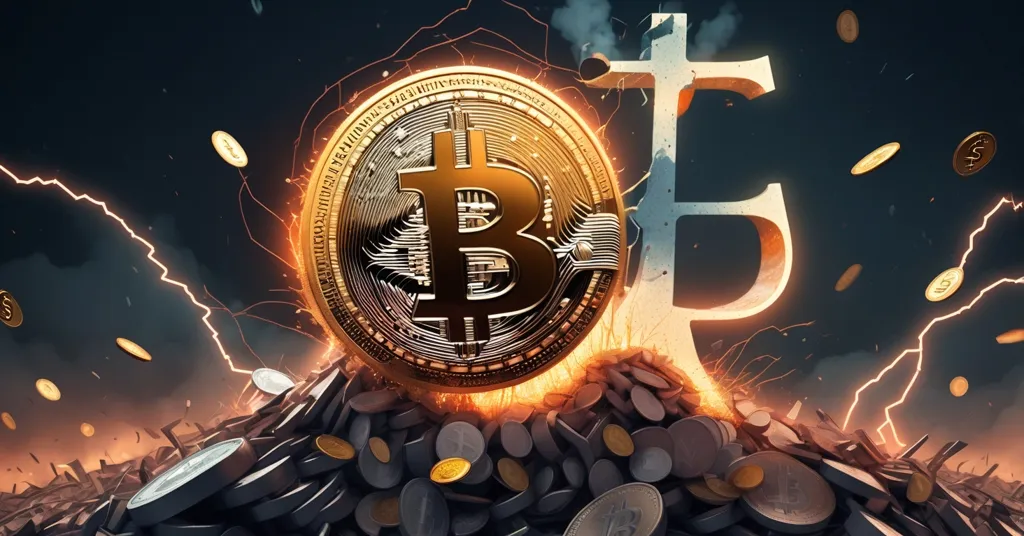Euro Surges Past $1.20 Forecast: Bitcoin’s Chance to Shine Amid Fiat Volatility

Wall Street Predicts Euro to Soar Past $1.20: A Wake-Up Call for Bitcoin?
Wall Street’s biggest players are placing hefty bets on the euro smashing through the $1.20 barrier soon, spotlighting a shaky U.S. dollar and raising eyebrows about the stability of fiat currencies. With the euro already up over 12% this year, driven by looming Federal Reserve rate cuts and jittery investors dodging U.S. policy uncertainties under President Trump, the stage is set for a financial shake-up that could push more folks toward Bitcoin and decentralized alternatives.
- Euro Momentum: Surged over 12% in 2024, peaking at a four-year high of $1.19 before easing to $1.17.
- Wall Street Bets: Goldman Sachs targets $1.25, JPMorgan $1.22, and UBS $1.23 in the near term.
- Crypto Connection: Fiat volatility could turbocharge interest in Bitcoin as a safe haven from currency swings.
The Euro’s Unstoppable Climb: What’s Happening?
The euro is on a tear, having notched a 12% gain this year and briefly touching $1.19—a level unseen in four years—before settling at $1.17 recently. This isn’t just a random spike; it’s a full-blown rally catching the attention of global markets. Major financial heavyweights are doubling down with bold predictions, as Wall Street banks forecast the euro surpassing $1.20 in the near future. Goldman Sachs is out front, forecasting the euro could hit $1.25 within a year. JPMorgan isn’t far off, eyeing $1.22 by March, while UBS anticipates $1.23 before 2025 kicks off. A Bloomberg survey piles on, with most banks expecting the euro to cruise past $1.20 by the third quarter of next year. This isn’t a fleeting trend; it’s a loud signal of shifting financial tides.
What’s behind this surge? The U.S. dollar is looking like a punch-drunk boxer, wobbling under the weight of expected Federal Reserve rate cuts that shrink the once-fat gap in returns compared to Eurozone banks (known as the interest rate differential). Add to that a growing unease with U.S. economic moves under Trump, and you’ve got pension funds and big institutions hedging against the greenback like it’s a bad bet. Hedging, for the uninitiated, means protecting investments by betting on another currency—in this case, the euro—to offset potential losses. Jackie Bowie, head of Europe, Middle East, and Africa at Chatham Financial, nailed the logic:
“As that interest rate differential closes, [hedging] potentially becomes more palatable to put in place.”
But there’s more than just numbers at play. Investor sentiment is tilting away from the dollar, and the evidence is stacking up. Peter Schaffrik, global macro strategist at RBC Capital Markets, didn’t hold back:
“We’ve just seen the tip of the iceberg. That’s at the helm of the dollar weakness we’ve seen, and there’s more to come.”
A June survey by OMFIF, a central banking think-tank, drives this home—reserve currency managers, those deciding where global wealth gets parked, are planning to beef up euro holdings over the next few years. Tomasz Wieladek, chief European macro strategist at T Rowe Price, called it what it is:
“Euro appreciation is a structural story, as reserve currency managers begin to pivot out of the US and the Fed cuts rates.”
Even Christine Lagarde, head of the European Central Bank (ECB), is riding the wave, dubbing the euro’s rise a “global euro moment” that screams international confidence in the currency. Sounds great, right? Well, not so fast—there’s a flip side to this euro flex.
Wall Street Cheers, ECB Sweats: The Double-Edged Sword
While Wall Street is popping champagne over the euro’s strength, the Eurozone isn’t exactly throwing a party. European exporters are getting squeezed hard—a stronger euro means their goods cost more on the world stage, potentially slashing profits and competitiveness against cheaper alternatives from other regions. Then there’s the inflation headache. A beefier euro pushes prices down by making imports cheaper, which sounds nice until you realize the ECB is already struggling to hit its inflation targets. Too low, and the economy risks stagnation. Luis de Guindos, an ECB rate-setting committee member, laid out the stakes:
“A euro above $1.20 would make things much more complicated.”
That $1.20 mark is a critical threshold—a line where the euro’s muscle could seriously bruise European economies by jacking up export costs to unsustainable levels. ECB officials are reportedly mulling rate cuts to cool the currency’s jets, though not everyone’s convinced it’s urgent. Dominic Bunning, head of G10 FX strategy at Nomura, reckons a slow creep upward might not spook the ECB if domestic demand holds firm. Still, it’s a high-wire act, and any misstep could ripple through global markets.
But not every suit on Wall Street is singing the euro’s praises. Citi’s playing the grumpy bear, predicting a slide to $1.10 within 6 to 12 months if the U.S. economy stages a comeback. It’s a stark reminder that currency forecasting isn’t a crystal ball game—even the big dogs can’t agree. And while they bicker over fiat’s future, a parallel narrative is brewing that could steal the spotlight.
Fiat Volatility: A Red Carpet for Bitcoin and Crypto?
While Wall Street obsesses over euro-dollar tug-of-war, a quieter revolution simmers in the crypto space—one that could feast on this very uncertainty. Every Fed rate cut, every ECB dilemma, every exporter’s gripe screams one truth: centralized fiat systems are a rigged game. Bitcoin, often likened to digital gold for its detachment from government meddling, offers a way out. With a fixed supply of 21 million coins and no central banker pulling strings, it’s a hedge against the whims of fiat volatility. When currencies like the dollar and euro yo-yo based on policy tweets or inflation fears, Bitcoin’s appeal as a borderless, censorship-resistant store of value sharpens.
Historically, fiat crises have nudged Bitcoin into the limelight. Think back to the 2011-2012 Eurozone debt mess—Bitcoin was just a baby then, but its price ticked up as folks sought alternatives. Fast forward to 2020, when dollar uncertainty amid pandemic stimulus sparked a BTC rally past $20,000. Today’s euro surge and dollar wobble could be another spark. Imagine European businesses, stung by a too-strong euro, turning to stablecoins on Ethereum for cross-border deals to dodge currency risk. Or U.S. investors, spooked by a shrinking dollar, stacking sats to preserve wealth. It’s not just theory—fiat chaos is crypto’s best marketing.
That said, let’s play devil’s advocate. Bitcoin isn’t a magic fix. Its own price swings can make fiat look tame—down 20% one week, up 30% the next. Regulatory clouds loom too; if fiat volatility drives mass crypto adoption, don’t be shocked if the ECB or Fed clap back with tighter rules to keep their grip on money. Still, even with these hiccups, the core case holds: centralized money is fragile, and decentralized systems offer a real shot at freedom. Bitcoin maximalists might roll their eyes at altcoins, but Ethereum’s smart contracts and DeFi platforms like Uniswap are crafting parallel economies. Stablecoins like USDC could see a bump in Europe if the euro gets too wild for local trade. Niche or not, these tools matter.
Risks, Structural Shifts, and the Bigger Picture
Beyond immediate forecasts, there’s a deeper shift afoot in global finance. The OMFIF survey isn’t just trivia—it hints at a slow pivot from the dollar as the world’s go-to reserve currency. If reserve managers are piling into euros, what’s stopping them from eyeing crypto as a future store of value? Decentralized finance (DeFi) could sneak into the gap left by fiat’s musical chairs, offering systems untied to any nation’s policy blunders. But it’s not all rosy for the euro either. If Citi’s $1.10 call pans out—banking on a U.S. rebound—it could flip the script, proving fiat’s unpredictability once again. Either way, the chaos is a glaring ad for why we need to accelerate beyond traditional money.
Another wrinkle: how might euro strength hit crypto miners in Europe? Energy costs, often tied to currency fluctuations, could spike if the euro keeps climbing, making mining less profitable unless offset by BTC price gains. It’s a small but real ripple effect showing how intertwined fiat and crypto worlds remain—for now. And let’s not ignore the ECB’s potential moves. Rate cuts to tame the euro could spark broader economic instability in the Eurozone, setting an even louder stage for Bitcoin as a hedge against inflation or deflation, whichever poison picks first.
Key Takeaways and Burning Questions
- Why is the euro rising against the dollar in 2024?
It’s up over 12% due to expected Federal Reserve rate cuts, a shrinking interest rate gap with the Eurozone, and investor unease over U.S. policies under Trump. - What do Wall Street giants predict for the euro’s value?
Goldman Sachs sees $1.25 within a year, JPMorgan targets $1.22 by March, and UBS forecasts $1.23 by year-end, with most banks eyeing past $1.20 soon. - What risks does a stronger euro bring to Europe?
It slams exporters by making goods pricier globally and drags inflation lower, complicating ECB goals and possibly triggering rate cuts. - How could fiat currency volatility boost Bitcoin adoption?
Uncertainty in dollar and euro values exposes centralized money’s flaws, positioning Bitcoin as a decentralized hedge untouched by central bank whims. - Is there a larger shift in global reserve currencies?
Yes, reserve managers are increasing euro holdings per OMFIF surveys, hinting at a dollar pivot that could spotlight DeFi and crypto as alternative reserves. - Are there bearish views on the euro’s trajectory?
Citi bucks the trend, predicting a fall to $1.10 in 6 to 12 months if the U.S. economy rebounds, showing the uncertainty in fiat forecasting. - Could altcoins or DeFi play a role amid this chaos?
Absolutely—Ethereum-based stablecoins like USDC could gain traction in Europe for stable trade if the euro gets too volatile, filling niches Bitcoin doesn’t.
Zooming out, the euro’s push toward $1.20 isn’t just a Wall Street headline—it’s a blaring siren on fiat’s fragility. Every central bank twitch, every currency swing, is another shove toward decentralization. Sure, Bitcoin isn’t perfect, and regulators might throw punches, but the case for disrupting the status quo has never been stronger. For those of us championing effective accelerationism, this fiat drama is pure rocket fuel. While the suits play their currency chess, let’s keep building the future of money—one block, one sat, one smart contract at a time.



